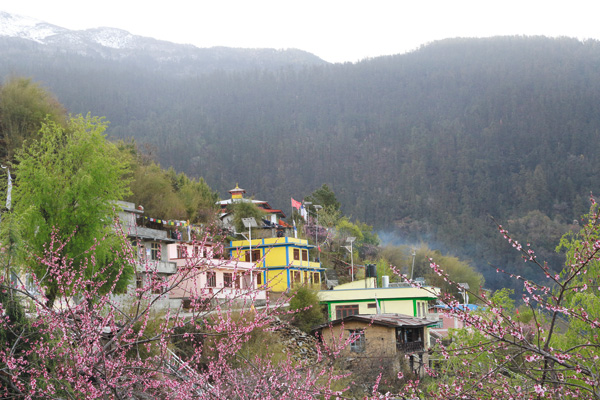Tibet, Nepal retain close ties throughout history
Updated: 2015-04-24 11:25
By Da Qiong and Palden Nyima in Nyanang county, Tibet(China Daily USA)
|
||||||||
 |
|
Lixin village in the Himalayas is a Sharpa settlement. Sharpas are an ethnic group living in the east of Nepal and the southwest of Tibet. Photos by Daqiong / China Daily |
Shared culture leads to marriages between neighbors going back to seventh century
Residents of China's Tibet and its bordering Nepal have retained close relations over thousands of years, as a result of frequent exchanges.
"The marriage of Nepalese Princess Bhrikuti to Tibetan King Songtsan Gampo in the seventh century is a real testimony to that relationship," said Nepali Vice-President Parmanand Jha in 2014.
The Wadi Sangpo statue in Phakpa Lhakhang Temple in Gyirong county was brought by Princess Bhrikuti at that time as a gift to Tibet, and is lasting evidence of the historic marriage.
Just as throughout history, the close ties remain today, with ever-increasing exchanges in border areas such as Lixin village in Tibet's Dam township.
Ngakwang Droma is from a Sherpa community in eastern Nepal's Gire township. She married a Sherpa man in the neighboring Lixin village last year.
"We share the same culture and we both cherish our marriage," said the 21-year-old Nepali woman.
Ngakwang Droma came to Lixin with her family 15 years ago.
Because of her long stay, she is now able to speak Nepalese, Tibetan, Sherpa dialect and Chinese.
Gire is about 70 kilometers away from Dam, and Ngakwang Droma has long regarded Lixin as her home.
Her three-day-wedding took place in April 2014 and Ngakwang Droma and her husband Nyima Dorje now operate a small shop in the village.
- Are you prepared to welcome the second royal baby?
- Spain recalls Venezuelan ambassador over Maduro conspiracy comments
- Anniversary of Armenian massacre marked
- DPRK to establish 2nd intl tourist zone
- Parade rehearsal held for Victory over Fascism in Russia
- Kim likely to visit Russia in May for war victory ceremony

 Honored for community work
Honored for community work
 5th Beijing International Film Festival closes
5th Beijing International Film Festival closes
 Top 10 auto lookalikes in China
Top 10 auto lookalikes in China
 Flights cancelled as ash cloud pours from Chile volcano
Flights cancelled as ash cloud pours from Chile volcano
 Unusual but true: Kung fu girl stuns TV show judges
Unusual but true: Kung fu girl stuns TV show judges
 100th anniversary of Armenian massacre marked worldwide
100th anniversary of Armenian massacre marked worldwide Volcano erupts in southern Chile, belching ash, smoke into sky
Volcano erupts in southern Chile, belching ash, smoke into sky
 Across Canada (April 24)
Across Canada (April 24)
Most Viewed
Editor's Picks

|

|

|

|

|

|
Today's Top News
Ho Feng Shan: A man of compassion, courage
The real Apple Watch goes on sale Friday in China, US
China looks to top the bill in Hollywood productions
Panda to be inseminated via China
Chinese mourn passing of US officer
Sino-US nuclear cooperation proposal lauded
Furious 7 on track to be tops in China
As PayPal split looms, eBay plans to think small
US Weekly

|

|








